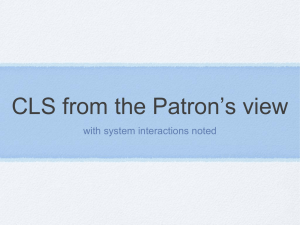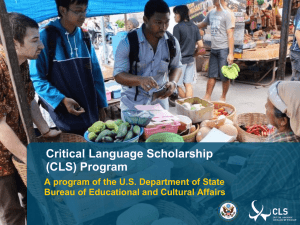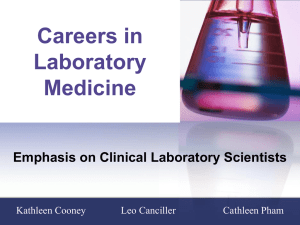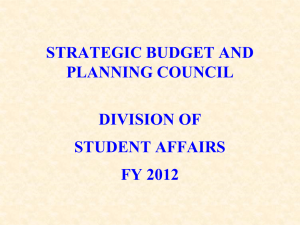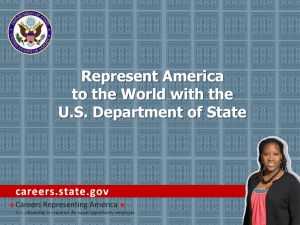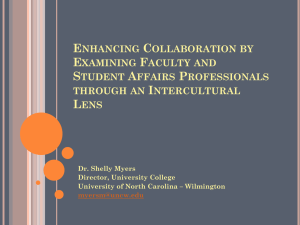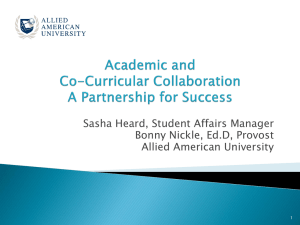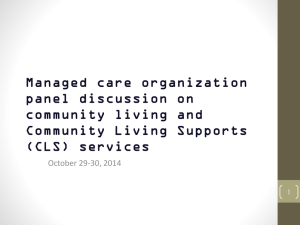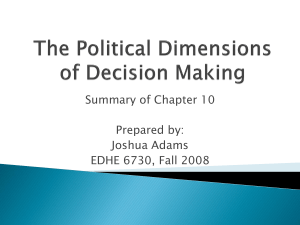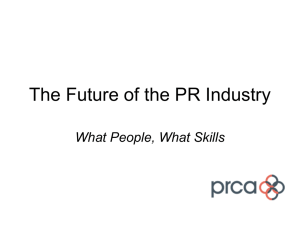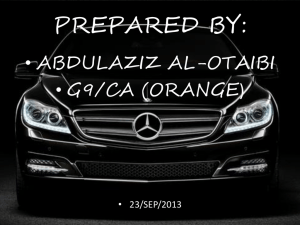Bureau of Educational and Cultural Affairs, US Department of
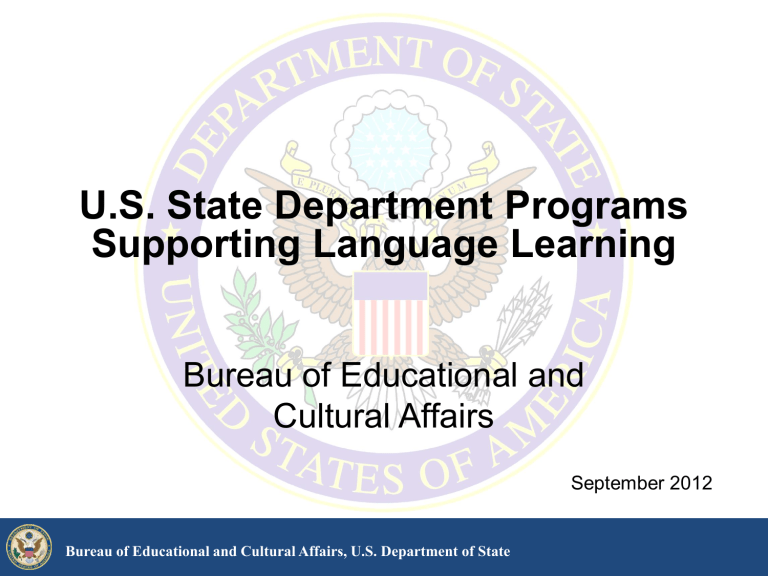
U.S. State Department Programs
Supporting Language Learning
Bureau of Educational and
Cultural Affairs
September 2012
Bureau of Educational and Cultural Affairs, U.S. Department of State
U.S. Department of State
Bureau of Educational and Cultural Affairs
(ECA)
Mission: to increase mutual understanding between the people of the U.S. and people in other countries through educational and cultural exchange.
Bureau of Educational and Cultural Affairs, U.S. Department of State
ECA by the Numbers
• More than 160 countries
• Over 1 million people around the world
• Approximately 310,000 Fulbrighters since 1946
• More than 50 Nobel Laureates
• Over 350 current and former heads of state
Bureau of Educational and Cultural Affairs, U.S. Department of State
Bureau of Educational and Cultural Affairs, U.S. Department of State
National Security Language Initiative for
Youth (NSLI-Y)
• Promote critical language learning among American youth (ages 15-18)
• Equip youth to use their language skills to
– advance international dialogue,
– compete effectively in the global marketplace,
– promote mutual understanding, and
– contribute to a more peaceful world
Bureau of Educational and Cultural Affairs, U.S. Department of State
NSLI-Y
Scholarships for American youth to study 7 critical languages in overseas programs:
Arabic, Chinese (Mandarin), Hindi, Korean,
Persian (Tajik),Russian, and Turkish
Summer (6 week) and Academic Year programs
Bureau of Educational and Cultural Affairs, U.S. Department of State
NSLI-Y SNAPSHOT
NSLI-Y started in 2006 as part of larger NSLI initiative
2006 – summer institutes in Arabic & Chinese (46 participants)
Current – Programs in 7 languages and 2 durations; over 600 participants/year
2,500 NSLI-Y Alumni
Participants from all 50 States
ALUMNI of STARTALK programs – 7%
Bureau of Educational and Cultural Affairs, U.S. Department of State
NSLI-Y Program Structure
• Overseas immersion experience
• Intensive language study
Summer programs (6 weeks) – 120 hours
Academic year programs – minimum 10 hours/week
• Cultural enrichment – activities & excursions
• Home-stays
• Programs implemented by American Councils for
International Education and partners
Bureau of Educational and Cultural Affairs, U.S. Department of State
Application now available for 2013-14 Program:
• Numbers : 625 scholarships available for 2013-14 o 525 Summer; 100 Academic Year
• Duration : o Summer programs in all 7 NSLI-Y languages o Academic Year programs in all except Persian
• Locations may include o China, Egypt, India, Jordan,
Korea, Morocco, Oman,
Russia, Taiwan,
Tajikistan, Turkey
Bureau of Educational and Cultural Affairs, U.S. Department of State
Eligibility o American citizen o 15-18 years old at program start; gap year welcome o All levels of proficiency; beginners welcome
Application Deadline: November 1, 2012
NSLIforYouth.org
Bureau of Educational and Cultural Affairs, U.S. Department of State
NSLI-Y – OPI Results
• ACTFL OPI Testing – started in 2011
• Summer 2011 participants: (6 weeks)
Pre-Program: Nearly 50% of participants had little or no experience with the language
Post-Program:
48.5% tested Intermediate or Advanced
Participants improved on average one or two levels
Bureau of Educational and Cultural Affairs, U.S. Department of State
NSLI-Y Summer 2011 OPI Results – All Languages
NSLI-Y – OPI Results
• Semester program – Fall 2011 and Spring 2012
Pre-program: 80% no knowledge or Novice
Post-program: 78% Intermediate; 5% Advanced
• Academic Year 2011-12:
Pre-Program: 82% no knowledge or Novice
Post-program: 75% Intermediate; 23% Advanced
Bureau of Educational and Cultural Affairs, U.S. Department of State
NSLI-Y Semester & Academic Year 2011-12
All Languages, N=88
NSLI-Y Alumni Survey 2012
• 86% of respondents continued to study their NSLI-Y target language self-study – 61% language classes – 58% volunteer work – 11% living in country – 8%
• 14% participated in other government-sponsored programs including STARTALK, Gilman, Boren, CLS,
Flagship (before or after NSLI-Y)
Bureau of Educational and Cultural Affairs, U.S. Department of State
NSLI-Y Alumni Reflections
• “I went from butchering a couple common words when I arrived to being understood in conversation with strangers when I left. Through language learning and through cross-cultural exchange, we can begin the conversation that makes cooperation between strangers on opposite sides of the globe possible.”
• “In only six weeks, I experienced things that changed my life in ways I never thought possible. I came to realize that as people, our uniting similarities matter far more than our distinguishing differences. The same thing that can make a child laugh or bring a smile to someone’s face in the United States will do the same in
China…”
Bureau of Educational and Cultural Affairs, U.S. Department of State
Bureau of Educational and Cultural Affairs, U.S. Department of State
Bureau of Educational and Cultural Affairs, U.S. Department of State
Gilman Scholarship for Study Abroad
• Scholarships for American undergraduates who are Pell grant recipients to study abroad for college credit
• In FY 2011, more than 2,300 scholarships to critical language countries
• 50 Critical Language Supplements (additional funding)
Bureau of Educational and Cultural Affairs, U.S. Department of State
Critical Language Scholarship Program (CLS)
Participants: U.S. undergraduate and graduate students.
Expectation: Participants will continue their language study beyond the scholarship period and apply their critical language skills in their future academic and professional goals.
Languages: 13 languages were offered for summer 2012:
Arabic, Azerbaijani, Bangla/Bengali, Chinese, Hindi, Indonesian,
Japanese, Korean, Persian, Punjabi, Russian, Turkish and Urdu. All
CLS institutes are located in countries where these language are predominantly spoken.
Competition: Over 5,200 applications received for 631 awards.
CLS Program Structure
Group-based summer intensive language instruction and structured cultural enrichment experiences.
4-5 hours of formal language instruction each day , five days a week, covering approximately one year’s worth of language study during the summer institutes.
Activities outside of formal classes are designed to complement language learning and include: tutoring, local peer conversation partners, cultural enrichment activities.
Summer only. 8-10 weeks.
CLS Program Diversity Snapshot (2012)
• 10% are STEM majors;
• 24% self-identify as a student of color.
• 225 institutions represented, including: public and private institutions, community colleges, and Minority-Serving Institutions.
• Undergraduate students (70%); graduate students (30%).
• Women (61%); Men (39%).
CLS Program Testing Data
All Languages
Novice
Intermediate
Advanced
Superior
Total
100%
90%
80%
70%
60%
50%
40%
30%
20%
10%
0%
2011 CLS Test Scores
Pre-Program
# of Students
192
% of Students
33%
325
67
1
585
56%
11%
0%
100%
Novice Intermediate
Pre-Program
Advanced
Post-Program
Post-Program
# of Students % of Students
40
350
7%
60%
189
6
585
32%
1%
100%
Superior
23
CLS IMPACT
CLS ALUMNI (2006-2011) SURVEY
1,152 alumni out of 2,767 responded to the survey
24
Who are CLS Alumni?
53% in degree programs
37% are employed
10% are “Other”
42% Bachelor’s programs
25% Master’s programs
29% Doctoral Programs
4% Other degree programs
(e.g. MD, JD)
63% full-time employment
37% part-time employment
Includes volunteering, fellowships
25
Continued Language Study
66% of alumni surveyed have continued formal study of their CLS language.
Which of the following methods do you use to study your CLS target language?
Mark all that apply.
Enrolled in classes at my college or university
Enrolled in classes at a local language institute
Enrolled in online courses
Participated in one-on-one or small group practice
Received tutoring
Studied abroad
Lived abroad
Other, please specify
0
17
80
50
53
100
170
180
173
229
150 200 250
406
300 350 400 450
26
Return to CLS Host Country
What was the main reason for your visit to your CLS host country?
Education
Work 20,5%
15,1% Leisure
Volunteer 3,3%
Residence
Other, please…
0,0%
2,4%
17,5%
41,3%
50,0%
• 32% of CLS participants went back to their host country after program completion. Of those who returned, 20% traveled for work.
•
99% say that participation in the CLS Program helped them during their future visit to the CLS host country either to some extent or to a great extent.
•
54% of CLS alumni plan to visit their CLS host country in the coming year.
27
Other Scholarships, Awards, Fellowships
• 186 CLS alumni respondents received a USG-funded scholarship, award or fellowship before participating in the CLS Program.
• 228 CLS Program alumni respondents received one after participating in the CLS Program.
Have you received any other U.S. government-funded scholarships, awards, or fellowships?
Title VIII Award (Research…
Overseas Research Center…
National Security Language…
2
3
7
9
11
Language Flagship Fellowship
Fulbright U.S. Student Program
5
9
13
4
9 Fulbright U.S. Scholar Program
Fulbright English Teaching…
Foreign Language and Area…
Critical Language… 3
14
Boren Award
Benjamin A. Gilman…
8
18
24
34
30
27
37
0 20 40 60
65
80
Yes, Before my most recent
CLS Institute
Yes, After my most recent CLS
Institute
82
100
28
CLS Alumni in Professional Fields
Educational institution
For-profit company
27,0%
23,0%
21,1% Federal government
Non-profit organization 15,1%
Other
International organization (e.g.
United Nations, World Bank)
Multi-national corporation 2,0%
Think tank
0%
1,0%
5%
6,3%
3,3%
10% 15% 20% 25% 30%
91% say participation influenced their career goals to some extent or a great extent.
68% use knowledge of their host country to some extent or a great extent at work.
67% say that the language skills they obtained helped them get their current job to some extent or a great extent.
36% are in jobs that require use of their CLS language
– usually more than 50% of the time.
29
Bureau of Educational and Cultural Affairs, U.S. Department of State
Critical Language Enhancement Award (CLEA)
• Open to Americans accepted to Fulbright program
• Before or concurrent with Fulbright award
• Three to six months language training
• Arabic, Bahasa, Indonesian, Bangla/Bengali, Chinese,
Gujarati, Hindi, Marathia, Punjabi, Russian, and Urdu
Bureau of Educational and Cultural Affairs, U.S. Department of State
Fulbright Foreign Language Teaching
Assistant (FLTA)
• Awards to young foreign teachers of English to teach their native languages on
U.S. campuses
• In 2011-2012, 440 Fulbright
FLTAs from 51 countries teach 32 languages on U.S. campuses in 50 states
• Arabic, Chinese, Hindi,
Turkish, Russian and Swahili
Bureau of Educational and Cultural Affairs, U.S. Department of State
Bureau of Educational and Cultural Affairs, U.S. Department of State
Intensive Summer Language Institutes (ISLI)
• Six week language “boot camp” for
U.S. teachers of Mandarin at the intermediate and advanced level
• Changchun, China
• Includes: peer tutors, enrichment activities and excursions, graduate credit hours, book and shipping allowance, room and board, airfare, and insurance
Bureau of Educational and Cultural Affairs, U.S. Department of State
Teachers of Critical Languages Program
(TCLP)
• U.S. K-12 schools host highly qualified teachers from the Middle East and
China for an academic year
• Open to U.S. school with developing and existing Mandarin and Arabic programs
• Program includes extensive orientation for exchange teachers, professional development workshops, and small grant opportunities
Bureau of Educational and Cultural Affairs, U.S. Department of State
Bureau of Educational and Cultural Affairs, U.S. Department of State
Questions?
Visit us at Exchanges.State.Gov
Bureau of Educational and Cultural Affairs, U.S. Department of State
